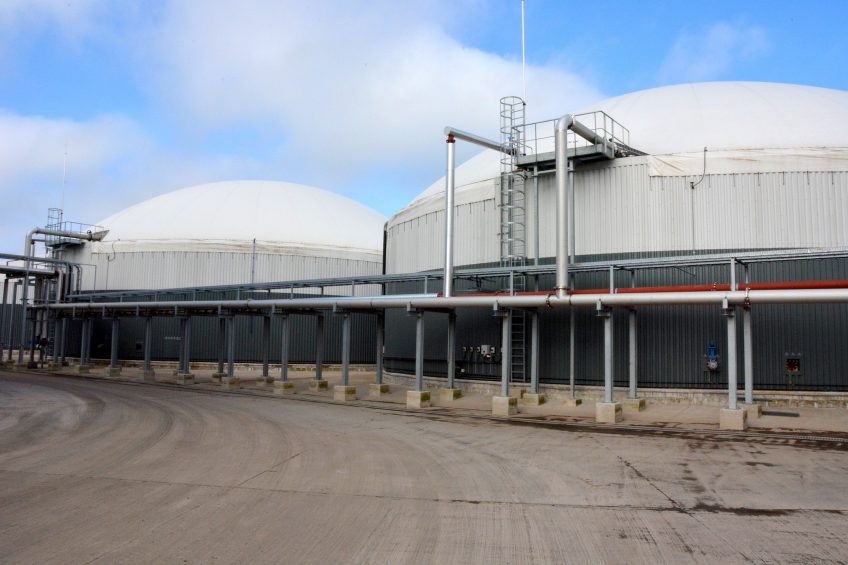Europe’s first poultry manure biogas plant in action

Biogas has the potential to turn muck to electricity, but using poultry manure has historically been a challenge. Poultry World explores a Northern Ireland site doing just that.
It has been eight years in the planning and took 18 months to build but finally Europe’s only biogas plant that is fuelled solely on poultry manure is running at full capacity.
Sited in part of a fully operational quarry in the heart of Northern Ireland the 3MW plant cost £23million to construct and can use up to 40,000 tonnes of poultry manure every year.
The Tully Centralised Anaerobic Digestion Plant was built near Ballymena in Country Antrim at Tully Quarry, on a site covered by a long-term lease to the quarry owners.
First of its kind
Dublin-based Stream BioEnergy developed the project which was built by Danish energy specialist company, Xergi, and local firm BSG.
Although there are other similar plants in China, this is the first poultry manure AD plant to be operational in the UK, Ireland or even the rest of Europe.
The total cost of the project was £23.3m of which Invest Northern Ireland provided a repayable £7.4million loan at a commercial interest rate, and £1.3million equity under the Sustainable Utilisation of Poultry Litter (SUPL) Scheme.
The balance of the project funding has been provided by a Foresight-managed fund Recycling and Waste LP, in which the UK Green Investment Bank is a cornerstone investor, as well as Xergi Limited.
Stream BioEnergy managing director Kevin Fitzduff told Poultry World the plant was operating well. “We are now running at full capacity and producing energy – the plant runs 24 hours a day seven days a week.”
Regulation
Northern Ireland is heavily saturated with poultry houses and has been searching for a suitable method to dispose of, or utilise, poultry manure in order to comply with fertiliser application rates as stipulated by the Nitrates Directive introduced by the European Commission.
While a number of small systems utilising manure have been investigated over the years by Northern Ireland’s department of agriculture, DAERA, none were actually brought into commercial production.
For now, the manure used by this new energy plant in Ballymena is delivered to the plant from around 100 poultry farms that are contracted to Moy Park.
While Moy Park is not an investor in the energy plant, it is responsible for arranging the transport of the manure to the plant in conjunction with McKnight Transport.
Employment
Mr Fitzduff says: “Xergi (the EPC contractor) provide operations services to the plant and have 12 full time staff on the site. In addition, many off-site jobs have been created through a range of contracting and professional services that the plant requires.
“Stream Bioenergy has five staff in total and is the original developer of the project. Stream Bioenergy is also an owner of the plant alongside the funders and we also provide management services to the project,” he said.
A unique system of technology from the Danish company Xergi inside the plant converts the raw poultry manure into energy.
This innovative technology strips the nitrogen as part of the process which allows up to 100% poultry manure to be digested.
In normal circumstances, it is difficult to convert large amounts of poultry manure in biogas plants because of the high levels of nitrogen level inhibiting the bacteria that produce biogas.
Nitrate management
However, in order to combat this challenge, Xergi developed the NiX technology, which reduces the nitrogen content in the biogas process.
Xergi CEO Jorgen Ballermann says: “It has been a long development process and we appreciate the patience and willpower that Stream BioEnergy has shown.”
Xergi has been contracted to manage operations for the first ten years, he says.
“It’s not enough to have a good biogas plant. It is essential that the operating staff know how to manage biogas plants. Therefore, we always supply biogas plants in combination with a well-developed training programme that ensures that employees can manage efficient operations of the plant.
“Based on this, Xergi has recruited and trained a group of local employees to manage operations. If there are unexpected challenges, we naturally have experts who come and assist the local staff, just as we have online access to the plant from our monitoring centre in Denmark,” said Mr Ballermann.
The new energy plant is tucked away into a corner site of the quarry to make it less visible from the road and to any local residents. The entire plant has been through a number of sound checks to ensure noise pollution is kept to a minimum. The only real area where the noise is high is in the engine room which has been well insulated.
Process
When the poultry manure arrives on site it is fed into two industrial sized hoppers with walking floors that feed it to the next stage where it is mixed with recirculated liquid before being pumped into the digesters.
During the mesophilic digestion process bacteria break down the litter and produce biogas. The total digestion time is approximately 45 days and the biogas produced by the plant is fed into two 1.5MW gas engines that generate electricity on site which is then sold to the National Grid.
Mr Fitzduff adds: “The digestate is pasteurised before being separated into a fibre and liquid fraction. Most of the liquid fraction passes through an ammonia removal process before being mixed with the incoming poultry litter.
“The remaining liquid and the fibre digestate are a safe nutrient rich fertiliser that can be used by farmers. The electricity is exported to the grid and is enough to power 4,000 homes.”
Stream Bioenergy say it has plans to further develop similar plants in Ireland. While this plant in County Antrim is using up to 40,000 tonnes of poultry manure a year, it is only about 20% of the total poultry manure produced in Northern Ireland.












